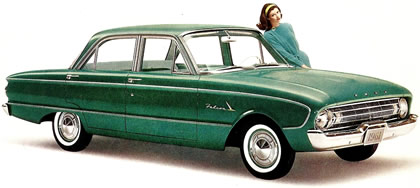If there was a simple fact that came out of the unexpected sales success of the 1960/61 Ford Falcon it was that the American public was ready for a subcompact car that was based on a six and would return reasonable mileage.
 Really, this shouldn’t have come as any great shock to the leaders of the Motor City at the time because Volkswagen was making massive (for the time anyway) inroads into the entrenched “Big Three” and other imports were having equal success. You could look up an down the streets of any neighborhoods and see Reualt Dauphine, the Messecherschmidt (yes the same as the fighter plane of World War II fame but this one featured three wheels, a front-opening door and about a 30 hp engine that, on a good day with a tailwind could still hit 50 going downhill – with the passengers and driver outside pushing), the MG line and, of course, at the time, ubiquitous Volkwagen.
Really, this shouldn’t have come as any great shock to the leaders of the Motor City at the time because Volkswagen was making massive (for the time anyway) inroads into the entrenched “Big Three” and other imports were having equal success. You could look up an down the streets of any neighborhoods and see Reualt Dauphine, the Messecherschmidt (yes the same as the fighter plane of World War II fame but this one featured three wheels, a front-opening door and about a 30 hp engine that, on a good day with a tailwind could still hit 50 going downhill – with the passengers and driver outside pushing), the MG line and, of course, at the time, ubiquitous Volkwagen.
Still, it did take some time for the folks in Detroit to realize that – wait a minute, people actually wanted utilitarian vehicles that returned good mileage.
So, Ford, which had had a small car in mind as part of both its now-defunction Edsel Division of Lincoln and the Falcon, knew that it had the world by the tail. It was a pretty standard layout, front-engine/rear drive, driven by a I-6 powerplant and the interior was nothing to write home about – vinyl on vinyl on vinyl with optional vinyl – but the Falcons still moved out the dealership doors as fast as they came in. (The competition, at the time, the air-cooled Chevy Corvair with its problems and the very quirky Plymouth Valiant – lines to remember, reverse curves on reverse curve and tiny angled taillights wasn’t really competition at all, so Ford had the market, with the exception of the imports, to itself).
In reality, the 61 was the second year the Falcon was offered and it underwent a slight facelift as the grille became concave chromed eggcrate, as opposed to convex. The rest of the design was pretty staid. The twin single-lens headlights were actually part of the front end and the front fenders were fared nicely, albeit blandly into the grille. The hood was one long piece of metal that had some overhang and moved smoothly to the windshield wipers. The wipers were, for the first time, sychronize d sweep style and the windshield was a fairly tall affair that moved up to a slightly rounded roof and on through a rear window that was also fairly vertical. The rear decklid was another flat member of the vehicle and the right- and left-rear quarters were somewhat rounded, but straight. The beltline was low and established by a single piece of brightwork. The rear end featured Ford’s first use of rounded taillights in a small vehicle and crhome in between.
The original powerplant was nothing to write home about, at 144-cubic-inches and about 85 horsepower. Test runs at the time showed that even bicycists could pass it on a 0 to 60 run and its top end was about 90. Some refinement pushed the powerplant out to 170-cubic-inches and 101 horsepower which, while it improved things, was still nothing to win any stoplight drag races (that was going to be up to future editions like the Futura and its 389, still some years in the future). The basic power team was a three-speed manual, although the Ford-O-Matic automatic was available.
When all was said and done, the Falcon – offered with 12 colors and 14 two-tone paint combes – Falcon, a mid-year entry to begin with sold more than 40,000 units its first six months and roughly quadrupled that tor the first full year – show Detroit that the buyer was ready for a good subcompact and Falcon was ready to lead the way.
